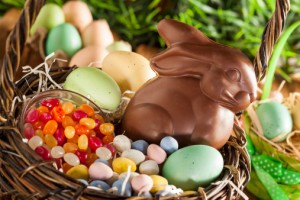Reduce your risk of cavities by avoiding the worst Easter candies for teeth.
When Easter rolls around, many kids expect a big basket stuffed with artificial grass, toys, and candy. Many adults 
Unfortunately, Easter candy can be bad for your teeth, especially if you don’t brush and floss as much as you should. Here are some of the best and worst candies to eat this Easter.
Worst Easter Candy
Peeps: Marshmallow peeps are an Easter staple, but they’re definitely not good for teeth. First of all, they’re basically pure sugar, which is an ideal food for the plaque bacteria that cause tooth decay. Secondly, they’re sticky, so they’re going to get stuck on teeth and provide a convenient buffet for those bacteria to snack on for hours at a time.
Jelly Beans: Jelly beans present many of the same problems as Peeps. They can easily get stuck in nooks and crannies of teeth and contribute to tooth decay. And because they are chewy and sticky, they could potentially even loosen dental restorations.
Filled Chocolates: Whether you’re talking about a chocolate crème egg, a chocolate-covered marshmallow bunny, or any other type of filled Easter chocolate, what you really have on your hands is a sugar bomb. The stickier the filling, the risker it is for your teeth.
Better Easter Candy
Of course, there’s really no such thing as Easter candy that is actually good for teeth. But there are some Easter favorites that are less likely to result in cavities or damage.
Hollow Chocolate Bunnies: No Easter basket would be complete without a chocolate bunny, and the good news is that as long as you choose a hollow one, it’s really not that bad for teeth. Biting through the thin chocolate is not going to leave as much residue as sinking your teeth into a solid hunk of chocolate would. Hollow chocolates also provide a smaller serving of chocolate and therefore less sugar than a filled chocolate of the same size.
Jordan Almonds: Although Jordan almonds are not often thought of as a traditional Easter candy, they do come in a festive selection of pastel colors that, along with the egg-like shape of the almond, match the Easter theme perfectly. The advantage of Jordan almonds is that they have a very thin layer of sugar on top of a crunchy nut that is packed with calcium—a nutrient very important for healthy teeth.
Sugar-Free Candy: One final option for smile-friendly Easter candy is sugar-free candy. You may have to search around to bit to find it, but they do make sugar-free Easter chocolates and even sugar-free Peeps.
No Matter What You Eat…
…Always Brush Afterwards!
Of course, no matter what type of food you are eating, you need to brush your teeth (or at least rinse your mouth) after indulging in order to protect against the harmful effects of tooth decay. If you have questions about caring for your teeth at home, please do not hesitate to contact California Dental Group.

